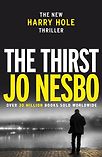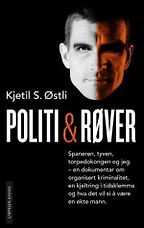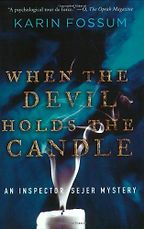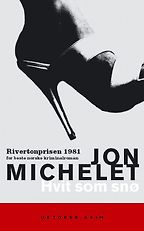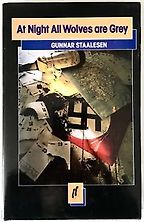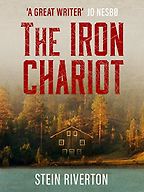Your first book is Cops and Robbers by Kjetil Stensvik Østli.
This is a non-fiction crime book which focuses on one bank robber and one policeman. It’s the history of bank robbing in Norway which was very big, especially back in the 90s. There was one big famous robbery in Stavanger in 2004 when they robbed the Nokas teller central and made off with over $9 million. It was the largest robbery in Norwegian history.
The robbery really felt like a scene from the film Heat, with a big shoot-out and the criminals using automatic weapons and one officer even being killed. After that the cops came down hard on the bank robbers and they more or less wiped out the two big gangs who were doing the robbing.
The book is meant to provide a unique insight into the police and criminal mind set, isn’t it?
What the book does is show us how the mentality of the robber is actually very similar to the mentality of the police. And that is true for the main character in my book, Harry Hole. He experiences the same. The people he feels he can most relate to are the criminals that he is hunting.
Your next book is Karin Fossum’s When the Devil Holds the Candle.
I remember reading the first 30 pages of this book and I was stunned. I had just got news that my first novel was going to be published, and I really didn’t know that much about Norwegian crime so I picked up a book by Karin Fossum. I was told that she is the best Norwegian writer—she is actually known as the Queen of Norwegian Crime. And the reason I was so stunned after 30 pages was because of the quality of her writing—it was so much better than I thought it would be.
If you didn’t really rate crime novels what made you decide to write them?
Well, I got into writing through reading the great Norwegian writers like Henrik Ibsen but also American and English writers like Ernest Hemingway and Mark Twain. Jim Thompson and Lawrence Block were the only crime writers I had read before I started writing.
Get the weekly Five Books newsletter
But I wanted to write and I wanted the easy way out so I decided to write crime. And no, it wasn’t the easy way out but I thought that my first novel wouldn’t get published so I thought on my first attempt I will write something that isn’t that time-consuming and in order to do that I have to write something which already has a head and a tail, so I thought, OK, a crime story. I know how to construct a crime story so I can send it into a publishing house and then it will be rejected with a polite letter of rejection asking me to send them something else. And then that is my chance to write the big European novel.
But it didn’t turn out that way.
No, I got caught up in crime.
And you started reading crime novels. Your next book is White as Snow by Jon Michelet.
I remember reading this in the 80s. It was one of the few Scandinavian crime novels that I had read. At this time the whole crime scene was very political and Michelet was one of the left-wing writers. And I was surprised that it was not only left-wing but well-written as well.
Why?
Because, I think that when you mix agendas it very seldom becomes good literature. There are many examples from the 70s and 80s of books that were political and not very good but this one was an exception. You see, what was going on in the 70s and 80s was there was an extreme left-wing movement in Norway, a big communist party which was popular with people in their early 20s and 30s. Many of the people who are in powerful positions in cultural life in Norway now were left-wing radicals during the 70s.
At Night All Wolves Are Grey by Gunnar Staalesen.
I read that book as a student in Bergen in the 80s. Gunnar Staalesen is a crime writer of the Chandler school. He was a sort of Norwegian Chandler who wrote from Bergen and based many of his novels there. And it was a guide book into the Bergen mentality and the city of Bergen.
What is the Bergen mentality?
Bergen isn’t the biggest city in the Norway but it is the most urban. It has connections with the rest of Europe, places like Germany and also England. So it’s very small but still an international city on the west coast of Norway. People from there say they are not a Norwegian city; they feel they have their own identity. It is a charismatic city which they are proud of. So they are both funny and snobbish about their city at the same time.
It reminds me of the Inspector Morse series set in Oxford. I know there are lots of people who go on tours around the city to see where the action took place. Did you do that with this book?
The centre of Bergen is so small that I was always coming across streets or places that were in the book, and that was fun. It was like you almost couldn’t avoid the crime scenes in his books.
And is there a high crime rate there? Is it the type of place where that sort of thing really goes on?
Not really. But these books are huge – they have been translated into 12 languages and now there is a TV series.
Your last choice is The Iron Chariot by Stein Riverton.
This is a classic Norwegian crime story. It was written over 100 years ago. Riverton is regarded as the founder of the modern Norwegian crime novel and he is a great writer. Somebody might think he is a bit slow and old-fashioned but I really like his style of writing. As a character himself he was very colourful and really lived the life that you would expect an author to live – sex, drugs and rock’n’roll, that kind of thing.
So is this a Sherlock Holmes kind of style?
Yes, possibly. It is slow-paced. He doesn’t go into extreme details about the murder or sex. It is all hinted at so it feels a bit old-fashioned, but that’s the way they wrote back then. At the time he was controversial and seen as being too explicit even if it feels to us modern readers like he was only hinting at things. When I wrote my first novel I had no idea about Norwegian crime writing; it was only after that I chose to go back and read him. I saw him as a kind of source for the early crime writers.
May 10, 2010. Updated: February 4, 2023
Five Books aims to keep its book recommendations and interviews up to date. If you are the interviewee and would like to update your choice of books (or even just what you say about them) please email us at [email protected]
Five Books interviews are expensive to produce. If you've enjoyed this interview, please support us by donating a small amount.

